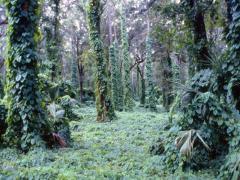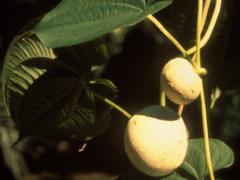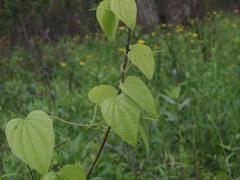Invasive Species: Dioscorea bulbifera, Air Potato
Air potato is an invasive herbaceous, twining vine that can grow to lengths exceeding 60 ft. (18 m). It invades open areas in the subtropical Southeastern United States. The leaves are alternate, 8 in. (20.3 cm) long, and broadly heart shaped, with prominent veins that resemble greenbrier leaves. The terete (rounded) stems are thin, wiry, and usually unwinged. Flowers are small and white, but the vine rarely flowers. Seeds, when produced, are unilaterally winged. The chief means of reproduction are aerial, potato-like tubers (bulbils) located at the leaf axils. Air potato can form dense masses of vines that cover and kill native vegetation, including trees, within a variety of habitats, such as forest edges, hammocks, and many disturbed areas. It was introduced from Africa for food and medicinal purposes in the early 1900s. Air potato is a common and widespread food crop throughout most tropical regions of the world.
What are invasive species, and why should we be concerned about them?
Taxonomy: Scientific and Common Names for This Species
Dioscoreales > Dioscoreaceae > Dioscorea bulbifera L.
Synonym(s): air potato, bitter yam, air-potato, air yam
Dioscorea bulbifera – USDA PLANTS Profile
Distribution Maps
air potato – The reported distribution of this invasive species across the United States (Source: Invasive Plant Atlas of the United States)
Up-to-the-minute distribution maps and why they are important
Reporting This Invasive Species
What is the best way to report the occurrence of an invasive species?
How to report an invasive species sighting to EDDMapS – Early Detection & Distribution Mapping System
EDDMapS – Report an invasive species to EDDMapS.
County Extension Offices – Find your county Extension office on this map provided by USDA.
How to Identify
This invasive species can be identified by looking for the characteristics described in the paragraphs that follow.
Vine
Air potato is an herbaceous, twining vine that can grow to lengths exceeding 60 ft. (18 m).
 |
 |
| Florida Division of Plant Industry Archive, Florida Department of Agriculture and Consumer Services, bugwood.org | Fred Nation, Weeks Bay National Estuarine Research Reserve, bugwood.org |
Foliage
The leaves are alternate, 8 in. (20.3 cm) long, and broadly heart shaped, with prominent veins that resemble greenbrier leaves. The terete (rounded) stems are thin, wiry, and usually unwinged.
 |
 |
| Amy Ferriter, State of Idaho, bugwood.org | Forest and Kim Starr, Starr Environmental, bugwood.org |
Flower
Flowers are small and white, but the vine rarely flowers.
|
|
|
| Karen Brown, University of Florida, bugwood.org | bugwood.org |
Fruit
Seeds, when produced, are unilaterally winged. The chief means of reproduction are aerial, potato-like tubers (bulbils) located at the leaf axils.
 |
 |
| Karen Brown, University of Florida, bugwood.org | James H. Miller, USDA Forest Service, bugwood.org |
Native Dioscorea Species Resemble Air Potato
Dioscorea villosa, wild yam – Images at invasive.org
 |
 |
| Karan A. Rawlins, University of Georgia, bugwood.org | Karan A. Rawlins, University of Georgia, bugwood.org |
Dioscorea quaternata, fourleaf yam – Images at invasive.org
 |
|
| Chris Evans, River to River CWMA, bugwood.org | bugwood.org |
Additional Images for Air Potato
air potato – Images at invasive.org
Learning Resources for Air Potato
Additional Information, Biology, Control and Management Resources
Control and management recommendations vary according to individual circumstances. Location, habitat, weather, and a variety of other conditions are factors that help determine the best treatment choice. To find the safest and most effective treatment for your situation, consult your state’s land-grant institution. If you will use chemicals as part of the control process, always refer to the product label.
United States Land Grant University System – Find your Land Grant University’s College of Agriculture, University Cooperative Extension Service, or other related partner on this map provided by USDA.
Invasive Species Management Plans for Florida – University of Florida, Center for Aquatic and Invasive Plants
A Field Guide for the Identification of Invasive Plants in Southern Forests – USDA Forest Service
A Management Guide for Invasive Plants of Southern Forests – USDA Forest Service
Florida National Forests Invasive Plant Series – USDA Forest Service
Element Stewardship Abstract – The Nature Conservancy
Identification and Biology of Nonnative Plants in Florida’s Natural Areas – University of Florida

